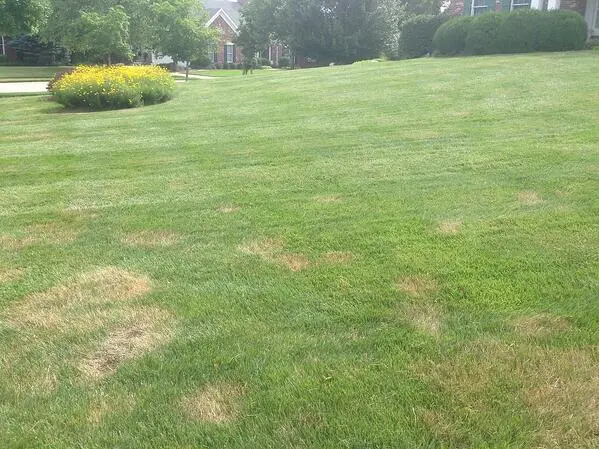Finally, the weather has cooled down, and more rainfall gives your sprinkler system a break.
But did you know you now need to worry about fall lawn diseases developing on your Wylie, TX lawn?
For example, if you water your lawn the evening before a hard freeze, you risk your turfgrass to a lawn disease—especially if the soil is saturated due to rainfall and overwatering your yard.
Also, water doesn’t evaporate as quickly in late fall and winter as in summer. Wet and cold weather provides the right environment for disease to develop—especially in North Texas, where we already deal with humid conditions.
One way to prevent lawn disease is to set your sprinkler systems to water less often than you do during the summer. Also, ensure that your sprinkler system is set to water during the early morning instead of waiting until after dinner.
While you can do all these preventative practices, you can still get a lawn disease. Here are the top lawn fungal diseases that affect North Dallas lawns:
- Brown Patch
- Dollar Spot
- Take-All Root Rot
- Pythium Blight
- Gray Leaf Spot
- Rust
- Slime Mold.
Commercial-grade fungicides, which only a professional landscaping company can apply to your lawn, are your best defense when it comes to turfgrass diseases. It’s vital that you call us at College Fund Landscaping as soon as you think your lawn has a fungal disease.
The Dark Side of Watering Before a Freeze
A quick rule of thumb: Don’t water your lawn if there’s a hard freeze in the forecast. The soil is already saturated, and the extra water with the freeze will encourage fungal growth.
That water won’t evaporate or sink deep into the soil before the hard freeze—especially if the soil is already saturated. The wet conditions and cold overnight temperatures create a breeding ground for turfgrass diseases, such as brown patch.
Granted, you may have heard that watering your garden plants before a frost helps to insulate them. But lawns already susceptible to disease will only get sick due to water laying on them overnight.
Read more: How to Treat Lawn Fungal Diseases in North Texas
Here are the common lawn diseases that are caused by pathogens and wet turfgrass overnight:
- Brown Patch
Brown Patch affects various Bermuda varieties, bentgrass, centipede grass, fescue, St. Augustine, and zoysiagrass. Look for irregular patches or circular blighted turf on warm season grasses. Patches can grow, especially in the fall, winter, and spring.
- Dollar Spot
Dollar Spot appears on most warm season grasses, but Bermuda grass and zoysiagrass are the most susceptible to the disease. Dollar Spot is active when there are warm, humid days, between 70 to 85°F, with nights that go down to 60°F.
Look for round, sunken, bleached-out patches. Alternatively, your turfgrass may look like straw. The spots will grow to connect with other spots to form large, irregularly shaped patches.
- Take-All Root Rot
Take-All Root Rot is also known as Bermuda Decline and Take-All Patch. This lawn disease attacks hybrid Bermuda, Common Bermuda, Bentgrass, Centipede grass, and St. Augustine grass.
This fungus is active in the fall and winter. However, you may not see the symptoms appear until spring or summer when your lawn is stressed due to hot, dry days.
Look for yellow leaves and thin grass roots. You’ll also notice that if you pull the infected turf out of the ground, Take-All Root Rot has affected the entire plant down to the roots.
- Pythium Blight
Pythium Blight, known as Cottony Blight and Greasy Spot, favors rainy, foggy weather in low-lying areas with poor air circulation. You may notice circular, dark, greasy, or slimy matted grass 2 to 12 inches in diameter.
If your lawn contains a hybrid Bermuda turf, it’s more susceptible to Pythium Blight. As the disease advances, mycelium forms, giving the turf a cottony look.
- Gray Leaf Spot
Gray Leaf Spot’s favorite host is St. Augustine grasses. Gray Leaf Spot thrives where there’s plenty of moisture and warm temperatures. Shaded St. Augustine turf tends to be more susceptible to Gray Leaf Spot.
- Rust
Rust’s favorite hosts include Common Bermuda, St. Augustine grass, and zoysiagrass. Warm, humid conditions and stressed turfgrass are the common denominators for your lawn to develop rust.
Learn more: The Scoop on Sprinklers: Common Problems with Irrigation Systems and How to Fix Them
The disease starts with rust-colored flecks that develop into raised blisters that contain powdery rust spores. These spores spread the disease. If your turfgrass develops rust, your lawn will thin with a yellow-orange or rust color.
- Slime Mold
Host turf, such as hybrid Bermuda, Common Bermuda, and St. Augustine grasses, are susceptible to slime mold. The Plant Disease Handbook from Texas A&M University says that if your turfgrass develops slime mold, your lawn’s leaves and stems will have this black residue.
You can spread slime mold when you walk through infected turfgrass. However, slime mold consumes dying organic matter, not healthy turfgrass.
Break the Cycle: Preventative & Systemic Fungicides
At College Fund Landscaping, we recommend that our customers invest in the GADA program, which includes
- Grub control
- Ant Protection
- Disease Prevention
- Aeration.
Our GADA program includes lawn disease prevention, including fungicides that block fungi from developing on your Allen or Frisco lawn. If your lawn has a turf disease, we recommend that you contact us to make a diagnosis and treatment plan to get your lawn back to health.
You can prevent lawn fungi from developing by changing your sprinkler system to water less frequently in the fall.
Also, stay off your turfgrass so you don’t spread the disease through your shoes, garden hoses, or your pet’s paws.
Even your mower and other lawn equipment can spread turfgrass disease throughout your lawn. So take care not to walk in diseased areas and wash your lawn equipment blades with bleach if it’s been in an infected area.
Why College Fund Landscaping Is the Best Choice for Taking Care of Lawn Diseases
Take our word for it: you should not be overwatering your lawn, especially right before a hard freeze. You want to prevent lawn diseases from starting, and keeping a drier lawn is the first step in the right direction.
If you think your lawn has fungi, call us today at 972-985-0279 or fill out our contact form. We’re happy to bring your lawn back to health with our fungicide treatments.
Sources: TAMU.edu, Texas Plant Disease Handbook.



Comments (0)
Thanks for your comment!
Thanks for your feedback! Your comments have been successfully submitted! Please note, all comments require admin approval prior to display.
Error submitting comment!
There is a problem with your comment, please see below and try again.